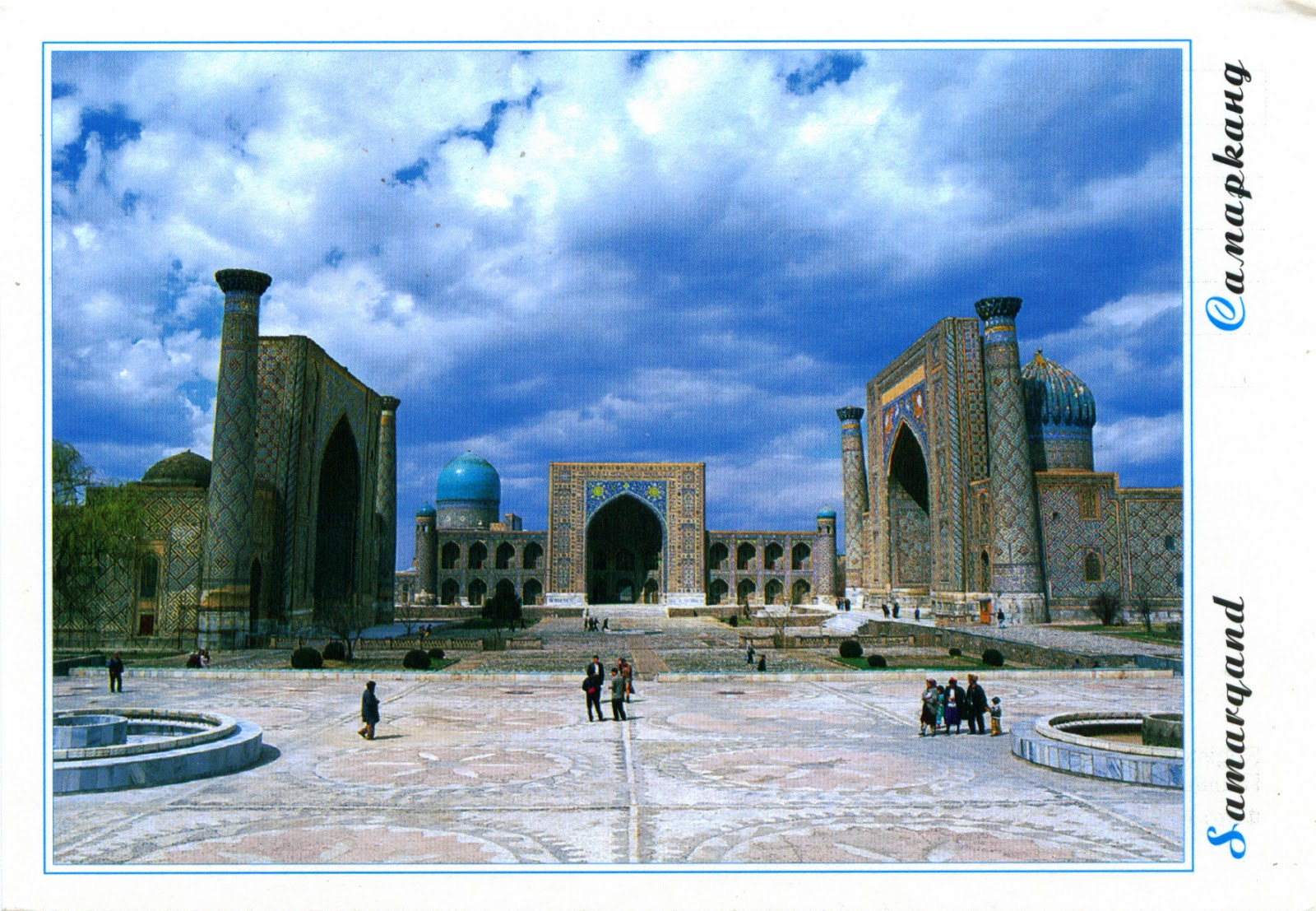 |
| 0901 Samarkand - The Registan and its three madrasahs. From left to right: Ulugh Beg Madrasah, Tilya-Kori Madrasah and Sher-Dor Madrasah. |
Posted on 14.12.2013, and 17.08.2014
Along with Bukhara, Samarkand, located in a large oasis in the valley of the Zerafshan River, is one of the oldest inhabited cities in the world, prospering from its location on the trade route between China and the Mediterranean (Silk Road). With a history of over two and a half millennia, it was the crossroads of world cultures, having its most significant development between 14th and 15th centuries, when it was capital of the powerful Temurid realm. Founded c. 700 BC by the Sogdians, it was successively conquered by Alexander the Great, Sassanians, Hephtalites, Göktürks, Sassanids, and Umayyad Caliphate.
 |
| 1187 Samarkand - Bibi-Khanym Mosque |
During this period, Samarkand was home to a number of religions, including Buddhism, Zoroastrianism, Manichaeism, Judaism and Nestorian Christianity, but after the Arab conquest of Sogdiana, Islam became the dominant religion. The Abbasid control was replaced with that of the Iranian Samanids, overthrown by Turkish tribes around the year 1000. Genghis Khan conquered and pillaged completely the city in 1220, killing all who took refuge in the citadel and the mosque.
After 150 years, another mongol, Timur, made Samarkand his capital, rebuilt it and populated it with great artisans and craftsmen. Timur gained a reputation as a patron of the arts and the city grew to become the centre of Transoxiana. In 1500 the Uzbek nomadic warriors took control of it, and in the 16th century the Shaybanids moved the capital to Bukhara, Samarkand entering into decline. The city came under Russian rule in 1868, and so remained until 1991, when Uzbekistan declared independence.
The architecture and townscape of Samarkand are masterpieces of Islamic cultural creativity, some ensembles playing a seminal role in the development of Islamic architecture. The historical part of Samarkand consists of three main sections: in the north-east there is the site of the ancient city of Afrosiab, to the south there are architectural ensembles and the medieval city of the Temurid epoch of the 14th and 15th centuries, and to the west there is the area that corresponds to the 19th and 20th centuries expansions, built by the Russians, in European style.
Registan ("Sandy place" in Persian) is the heart of the ancient city of the Timurid dynasty, a public square framed by three madrasahs (Islamic schools) of distinctive Islamic architecture, namely the Ulugh Beg Madrasah (1417-1420), the Tilya-Kori Madrasah (1646-1660) and the Sher-Dor Madrasah (1619–1636). Here people gathered to hear royal proclamations, heralded by blasts on enormous copper pipes called dzharchis - and a place of public executions.
Bibi-Khanym Mosque, whose name comes from the wife of 14th-century ruler, Amir Timur, was built using precious stones captured during his conquest of India. According to Ruy Gonzáles de Clavijo, 90 captured elephants were employed merely to carry precious stones. Construction was completed between 1399 and 1404, but the mosque crumbled to ruins over the centuries. In 1974 began the reconstruction, and the current mosque is effectively a brand-new building, as no original work remains.
About the stamps
On the postcard 0901 (Uzbekistan)
The first stamp is part of a large definitive series depicting the state coat of arms, about which I wrote here. The second stamp is part of the joint issues Kazakhstan - Uzbekistan issued on 2003, about which I wrote here.
On the postcard 1187 (United Kingdom)
The first two stamps are part of the definitive series about which I wrote here.
The third stamp is part of the series Remarkable Lives, which commemorates 10 famous people born in 1914, who have contributed and succeeded in their respective fields. The black and white images feature portraits of sportsmen, actors, writers and an even a spy:
• Alec Guinness, actor (1914-2000)
• Dylan Thomas, writer (1914-1953)
• Joe Mercer, football player (1914-1990)
• Abram Games, poster artist (1914-1996)
• Joan Littlewood, theatre director (1914-2002)
• Roy Plomley, producer, radio broadcaster, playwright, and novelist (1914-1985)
• Max Perutz, scientist (1914-2002) - It's on the postcard 1187
• Noor Inayat Khan, SOE agent during WW2 (1914-1944)
• Barbara Ward, economist and writer (1914-1981)
• Kenneth Moore, actor (1914-1982)
References
Samarkand - Wikipedia
Registan - Wikipedia
Samarkand - Crossroad of Cultures - UNESCO official website
Sender 0901: Shukhrat Rakhmatullaev (direct swap)
Sent from Tashkent (Uzbekistan), on 20.05.2013
Photo: A. Zueva
Sender 1187: Eileen McGhee
Sent from Chorley (Lancashire / England / United Kingdom), on 05.08.2014


No comments:
Post a Comment